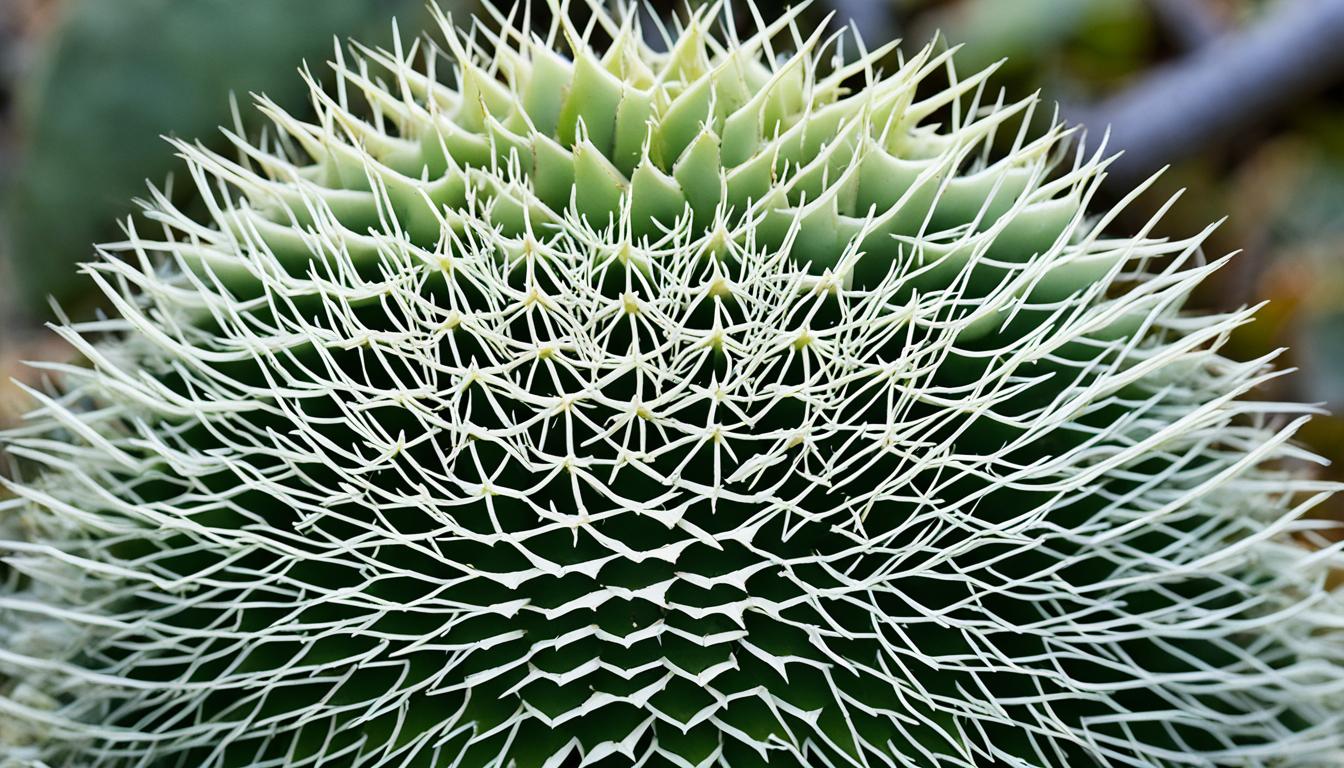Did you know the Fishbone Cactus is a special kind of succulent? It’s not a real cactus. This amazing plant is also called Epiphyllum anguliger. It has stems that look like a fish’s bones. People love it for adding an exotic touch to their homes. If you want to learn how to take care of this plant, you’re in the right spot. This guide has all you need to know about the Fishbone Cactus. You will learn about taking care of it, making more plants, and dealing with bugs. By the end, you’ll know how to keep your Fishbone Cactus happy and healthy at home.
Key Takeaways:
- Discover the unique features of the Fishbone Cactus, including its fishbone-shaped stems and captivating foliage.
- Understand why the Fishbone Cactus is a popular choice for apartment dwellers, thanks to its striking appearance and air-purifying properties.
- Learn about the specific care requirements of the Fishbone Cactus, including potting, light, watering, fertilization, pruning, and pest control.
- Gain insights into the various propagation methods to create new Fishbone Cactus plants and expand your collection.
- Explore the growth and development of the Fishbone Cactus, and understand how to promote optimum growth conditions.
Why Do We Love the Fishbone Cactus For Apartments?
The Fishbone Cactus is great for people in apartments. It has neat zigzag stems that look like a fishbone. This makes any room look interesting.
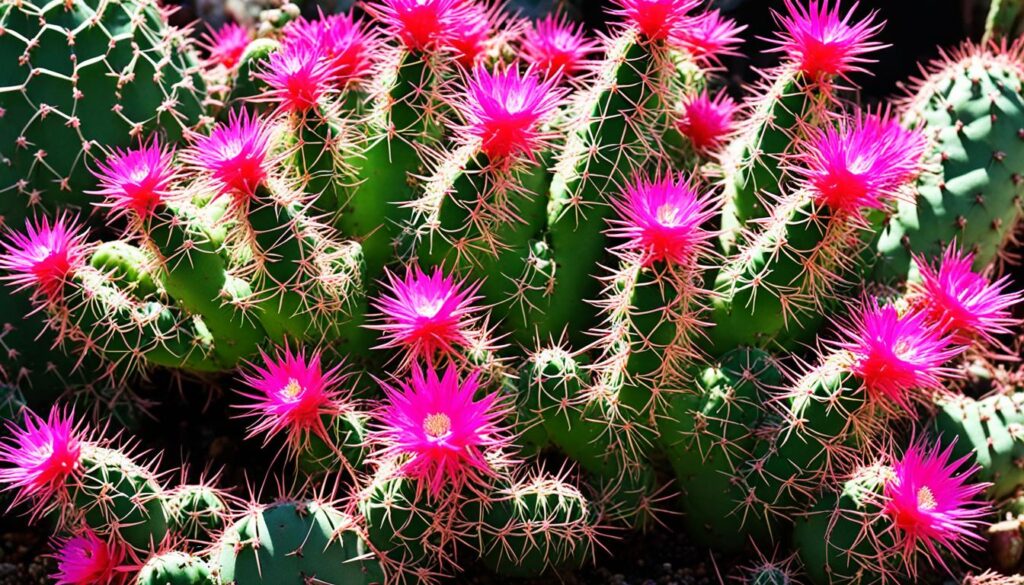
This cactus also cleans the air. It takes away bad stuff and makes the air better. So it makes your place look good and keeps you healthy.
It’s also safe for pets. It won’t harm cats or dogs. This is good news for pet owners who love plants.
About its size, the Fishbone Cactus can get big with care. But you can keep it small with some trimming. So it fits well in small places.
The Fishbone Cactus does a lot. It’s pretty, cleans the air, and is safe for pets. It brings nature into your home. It’s perfect for making an apartment feel nicer.
How to Grow a Fishbone Cactus – Learn to Grow this Indoor Beauty
To grow a Fishbone Cactus, learn its care needs. This guide covers all key care aspects. You will know how to pick the right soil and pot. And how to give it the light it needs. You’ll also learn the best watering habits and how to feed it. We will go over how to trim it and keep it healthy. You’ll also find out how to make more plants from it. Plus, how to keep bugs and diseases away.
Choosing the Right Pot and Soil
Choosing the right pot size is very important. A slightly bigger pot works best for growth. Use special soil for cacti and succulents to avoid too much moisture. This helps prevent root problems and keeps your plant happy.
Providing Adequate Light
Light helps your Fishbone Cactus grow well. It likes bright, indirect light, like under tree shadows. Put it near a window with indirect sun or use grow lights. Avoid too much direct sun to keep the leaves safe. The right light keeps your cactus healthy.
Watering and Humidity
This plant likes a bit dry conditions, like its natural home. Let the soil top dry before watering again, maybe every week or two. Change how often you water based on the room’s warmth and wetness. This cactus is okay with the usual moisture inside houses.
Nutrition and Fertilization
Feeding your cactus helps it stay strong. Use a good cactus food in spring and summer. Follow the food’s instructions for how much and how often. Don’t feed it too much to avoid harm. The right food keeps your cactus healthy.
Pruning and Maintenance
Cutting off dead or yellow leaves keeps your cactus looking nice. Also, take off too many or weak stems for better growth. Check for bugs and sickness often and fix any issues. Proper care keeps your cactus in great shape.
Propagation
Making more Fishbone Cacti is fun and easy. You can use stem cuttings or small offsets. Let the cut part dry, then plant in the right soil. Keep the soil a bit wet until it grows roots, then water less. Your new plants will grow well with care.
Monitoring for Pests and Diseases
Always watch for bugs or sickness in your cactus. Look out for pests like mealybugs and spider mites. Check the leaves, stems, and soil often. If you find pests, act fast to stop more damage. Safe bug sprays or soap can help keep your cactus safe.

Now you know how to care for a Fishbone Cactus. With the right soil, light, water, and food, it will grow well. Remember to trim it and watch for bugs. Your cactus will be beautiful inside your home.
Appearance of Fishbone Cactus
The Fishbone Cactus is very pretty and unique. It has stems that look like a fishbone. These stems hang down and look beautiful. The plant has a nice green color. It has long leaves too. This cactus can do well in many places because of how it looks.
To show you what it looks like, here is a picture of the Fishbone Cactus:
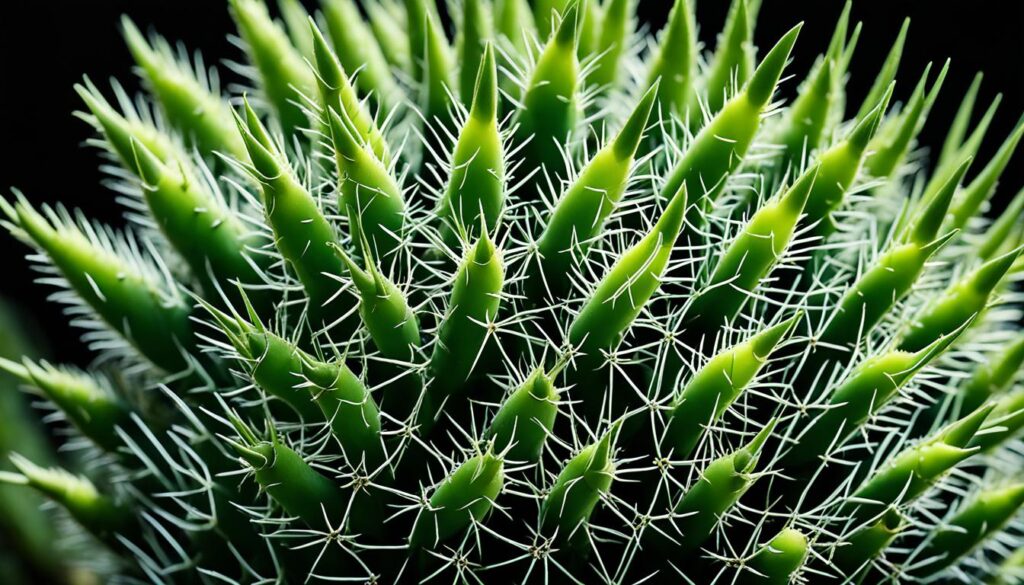
This picture shows how beautiful and special the Fishbone Cactus is. You can see the special stems that look like zigzags.
It’s good to know what this cactus looks like. This helps us see how pretty it is. And, it helps us spot if it starts to look sick or different.
Light Requirements for Fishbone Cactus
Good lighting helps fishbone cactus grow well. The right light makes it healthy and pretty.
This cactus likes bright, indirect light. It’s best by a window with sunlight that’s not too harsh. This keeps the plant from getting sunburned.
If the light is too low, the cactus might not grow right. It may stretch out too much. So, it’s good to have lots of light, but not too bright.
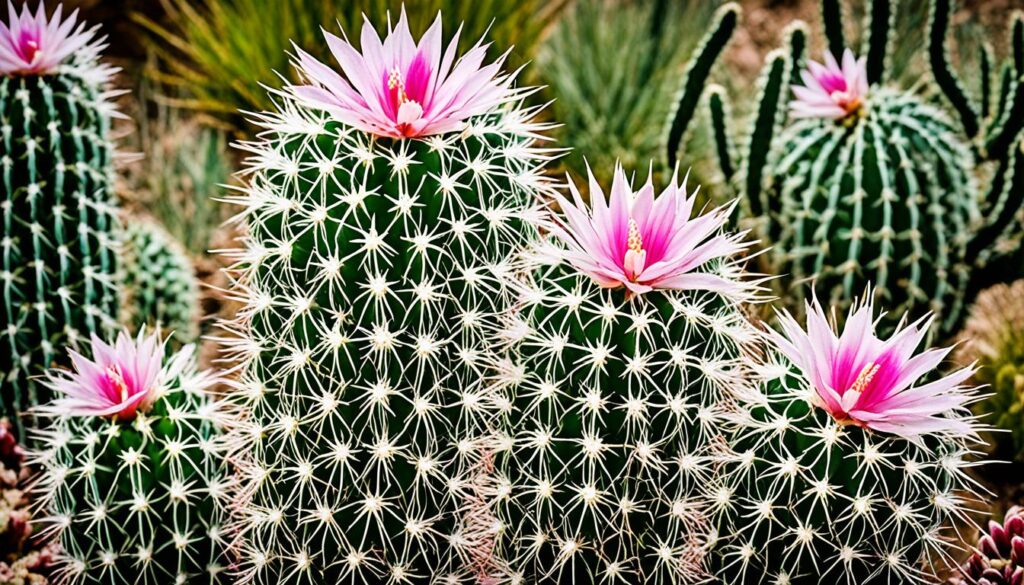
It’s key to find the perfect amount of light. Not enough light means weak stems and pale leaves. Too much direct sun can hurt the leaves, making them brown.
You can use lamps to give light, too. This is great when it’s dark a lot, like in winter.
Turning the plant now and then is smart. It helps the cactus grow evenly all over.
Watering Requirements of The Fishbone Cactus
Watering your Fishbone Cactus right is key to its health. You must know how much water it needs. I’ll share tips to water your cactus well.
Signs of Overwatering vs. Underwatering
Knowing if your cactus has too much or too little water is important. Here’s what to look for:
- Signs of Overwatering: Too much water causes root rot and other issues. Leaves may turn yellow or brown. Stems might get mushy. The soil can smell bad. Roots may also feel soft.
- Signs of Underwatering: Not enough water makes the cactus dry and stop growing. Leaves can shrivel. Stems become dry. The soil looks dry, too. Leaves might fall off or get brown edges.
It’s important to find the right amount of water for your cactus. This keeps it healthy.
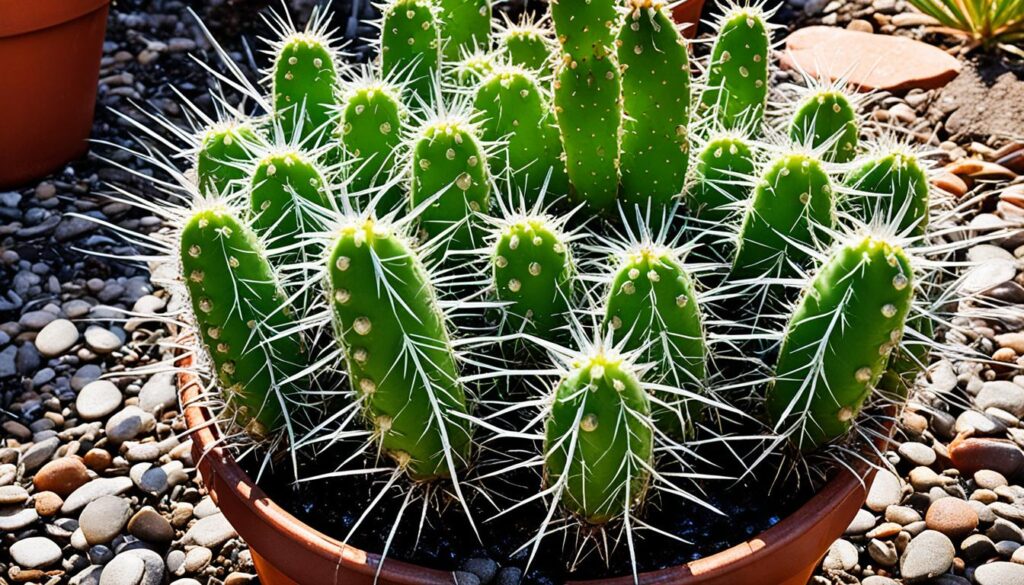
| Watering Requirements | Indoor Plant Watering Tips |
|---|---|
| Frequency: | Give your cactus plenty of water, then let the soil dry. How often depends on its home, pot size, and the time of year. Generally, water every 1-2 weeks in spring and summer. In fall and winter, water every 2-4 weeks. |
| Watering Technique: | Make sure water reaches all roots. Water until it drains out the bottom. Don’t let the plant sit in water. Use pots with holes and draining soil to avoid too much water. |
| Environmental Considerations: | Think about your room’s temperature and humidity. You might need to water more if it’s hot and dry. Water less if it’s cool and humid. |
Follow these tips to keep your Fishbone Cactus happy and well-watered. Watch for watering signs to tweak your routine as needed.
Fertilizing Fishbone Cactuses
Your Fishbone Cactuses need the right food to grow well and stay healthy. They need special nutrients you can find in fertilizers.
To pick the right food for your plants, use a cactus fertilizer. It should have more phosphorus and potassium. These help with flowers and strong plants. It should have less nitrogen. This stops too many leaves that are weak.
Feed your cactuses in spring and summer. This is their growing season. Don’t feed them in fall and winter. They don’t need much then.
Tip: Always follow the instructions provided on the fertilizer packaging for dosage and application guidelines specific to the brand you choose.
When feeding your cactuses, never give them too much. Too strong fertilizer can hurt their roots. Better to give them too little than too much.
Always water your plant before feeding it. Mix the fertilizer with water as told. Then, put it in the soil near the plant. Keep it off the leaves to prevent burn marks.
Feed regularly, but also give them enough light and water. Watch your plants and see what they need. Then, adjust how much food you give them.
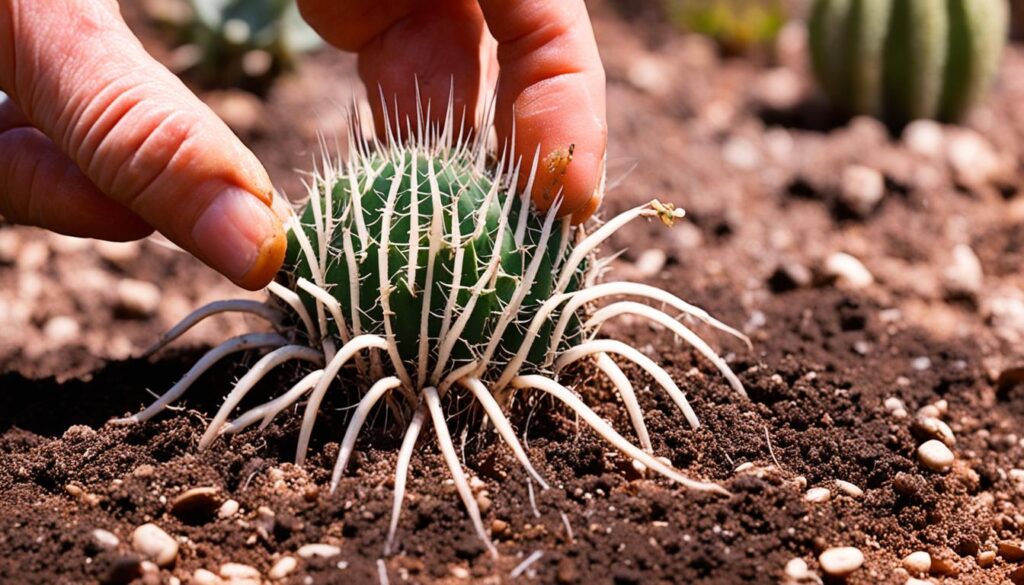
Potting Fishbone Cactuses
Potting is key for a healthy Fishbone Cactus. I’ll show you how to do it right. This includes the right pot size, the best potting mix, and when to repot.
Choosing the Right Pot Size
The right pot size helps your cactus grow well. Too small, and the roots can’t spread. Too big, and the soil stays too wet. Pick a pot just bigger than the cactus’s roots.
Using the Right Potting Mix for Fishbone Cactuses
A good potting mix is important. It gives your cactus what it needs to grow. The mix should drain well but keep some moisture. A mix made for cactuses works great.
Repotting When Necessary
Sometimes you need to repot your cactus. Do this if it’s too big for its pot. Or if the soil gets hard. Repot in spring or summer when it’s growing.
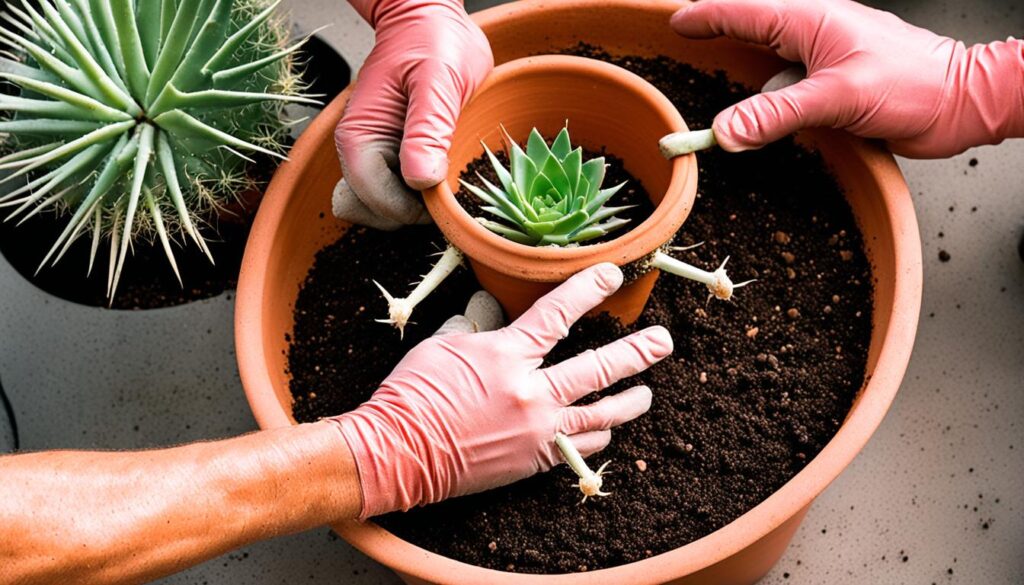
Be gentle when repotting. The stems can break easily. Use a pot that lets water out. Take the cactus out of the old pot carefully. Put it in a new pot with fresh soil. Make sure it stands up straight.
With the right pot, soil, and timing, your cactus will do well. It will grow big and beautiful.
| Key Points: |
|---|
| Choose a pot slightly larger than the current root ball |
| Use a well-draining potting mix |
| Repot when roots are tightly packed or growing through drainage holes |
Propagating Fishbone Cactuses
Creating new Fishbone Cactus plants is exciting. You can try different methods to do this.
Stem Cuttings Or Seeds?
Cutting a stem off is one common way. First, cut a healthy stem with something sharp. Let the cut stem dry for a few days. Then, plant it in special soil. Keep the soil a bit wet until the stem grows roots.
Another way is growing them from seeds. This takes longer and needs patience. Plant the seeds in special soil too. Keep the soil wet all the time. Put the pot in a place that’s warm and bright but not in direct sun. Soon, with care, the seeds will begin to grow.
Division Of A Fishbone Cactus
You can also cut a big plant into smaller ones. Do this when it’s too big for its pot. Take the plant out and carefully make it into smaller pieces. Make sure each one has roots. Plant them in their own pots with special soil. Then, take good care of them.
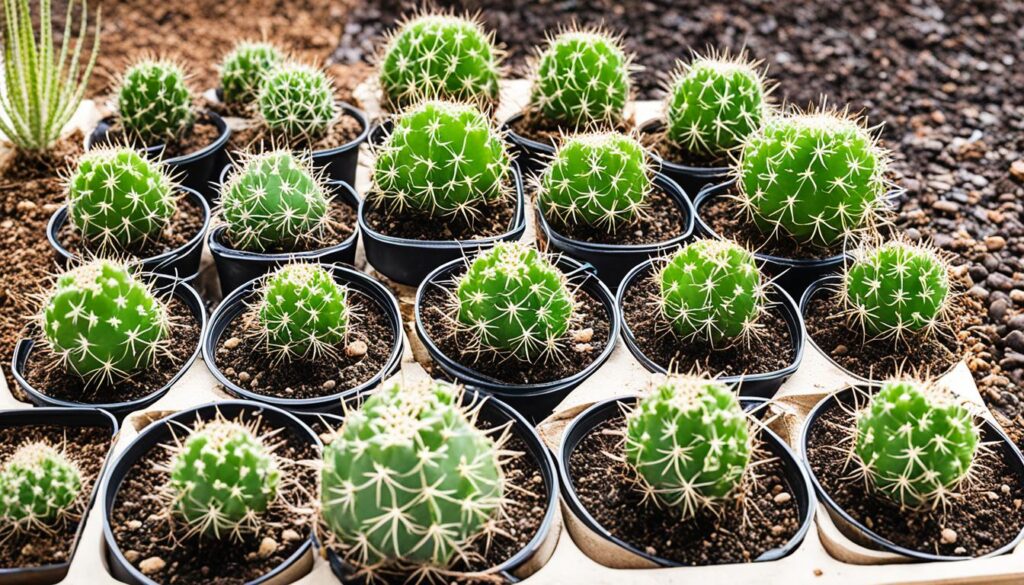
Propagating is a fun way to make more plants. You can use stem cuttings, seeds, or division. Using the right methods and care will help a lot. Try different ways and enjoy watching new plants grow.
Growth and Development of Fishbone Cactuses
Learning how Fishbone Cactus grows is key for its best care. As it gets older, it changes a lot. Each change needs different care. This helps us keep the cactus happy through its whole life.
A Fishbone Cactus grows in stages:
- Seedling Stage: It starts small from a seed. Soon, it gets its first real leaves.
- Juvenile Stage: Here, the cactus grows fast. It gets more leaves and its cool zigzag stems.
- Maturation Stage: The cactus is fully grown now. It has lots of stems and leaves. It might even start to flower.
Many things affect how fast and well a Fishbone Cactus grows. The best conditions for growth include:
- Light: It loves bright but not direct light. A spot near a window works great. The right light keeps it healthy.
- Temperature: It likes being warm, between 60°F and 80°F in the daytime. Cooler at night is good too.
- Humidity: Average room wetness is fine, but a bit more makes it happier. You can use a humidity tray or humidifier.
- Watering: Watering the right way is important. Let its roots dry out before watering again. Too much or too little water is not good.
- Pot and Soil: A good pot and soil help a lot. Make sure the pot lets water out to avoid too much moisture.
- Fertilization: Feeding it right helps it grow. Use fertilizer as the package says during its growing time.
Give these things to your cactus and watch it closely. This way, it will grow strong and happy in your home.
“Learning about the Fishbone Cactus’s growth helps us take care of it better. This keeps it healthy and strong at all times.”
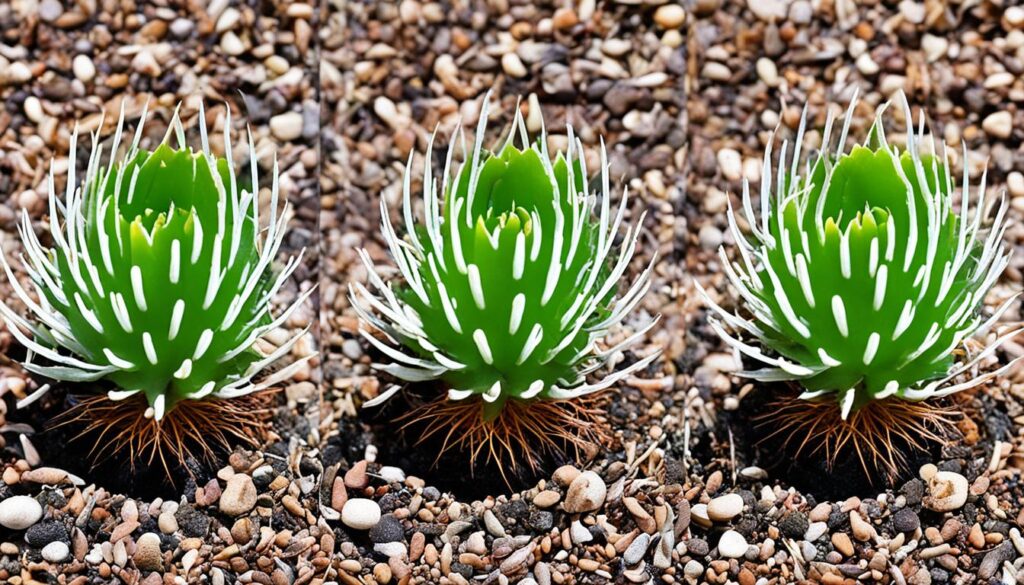
Dealing with Pests and Diseases in Fishbone Cactuses
Fishbone Cactus is strong. But it can still get sick or have bug problems. It’s important to watch out for these issues. This keeps your cactus healthy and happy.
Pest Control:
Some bugs like mealybugs, scale insects, and spider mites might attack. They can hurt the cactus leaves and make the plant weak. These bugs can also spread to other plants.
First, you need to spot bugs early. Check your cactus often for mealybugs, scale insects, or spider mites. Look for little white bugs, brown scales, or tiny webs.
Preventing bugs is very important. Keep your home clean so bugs don’t come. Always check new plants for bugs before bringing them home.
If your cactus gets bugs, try cleaning them off first. Use a cotton swab or water with a little soap. This might stop the bugs from spreading.
But if there are a lot of bugs, you might need special bug spray. Ask a plant expert or at a garden store for safe sprays. And always use them carefully.
Common Plant Diseases:
Fishbone Cactuses don’t get sick easily. But they can still catch some diseases.
- Rhizoctonia root rot: This disease happens if the soil stays too wet. It makes roots yellow, wilt, and rot. Water your cactus the right way and use soil that drains well to stop this.
- Mildew: Powdery mildew makes a white or gray dust on leaves. It likes wet air. To stop it, make sure your cactus gets plenty of fresh air. Water it carefully and keep the air around it not too wet.
- Stem and leaf rot: Too much water and wet air can cause the cactus parts to rot. Don’t water it too much and keep the air moving to protect your plant.
If you see any sick parts on your cactus, take action fast. Remove sick leaves or stems. Change how you water and let fresh air around the cactus. This helps stop diseases from spreading.
| Pest or Disease | Identification | Prevention | Treatment |
|---|---|---|---|
| Mealybugs | Small white cotton-like clusters | – Keep indoor environment clean – Inspect new plants | – Physical removal – Mild soap spray |
| Scale insects | Brown or gray scale-like insects | – Clean indoor space – Inspect new plants | – Physical removal – Mild soap spray |
| Spider mites | Tiny webbing and stippled leaves | – Clean indoor space – Moderate humidity | – Water spray – Neem oil |
| Rhizoctonia root rot | Wilting, yellowing, root rot | – Proper watering practices – Well-draining soil | – Adjust watering – Improve drainage |
| Mildew | White or gray powdery coating | – Air circulation – Moderate humidity | – Remove affected parts – Fungicidal spray |
| Stem and leaf rot | Rotting of stems and leaves | – Proper watering practices – Well-ventilated environment | – Remove affected parts – Adjust watering |
Common Fishbone Cactus Pests
Keeping your Fishbone Cactus healthy means knowing about pests. Knowing these pests lets you protect and keep your plant well.
Mealybugs: These pests are small, white, and look like cotton. They harm indoor plants like the Fishbone Cactus. They make leaves yellow, wilt, and stop growth. You can wipe them off with rubbing alcohol on a cotton swab.
Scale Insects: Scale insects hurt your Fishbone Cactus. They are small, brown or black bumps on the plant. They make a sticky mess and harm the plant. A soft brush with soapy water can remove them.
Spider Mites: Spider mites are tiny but bad for the Fishbone Cactus. They eat the leaves, making them yellow and fall off. They are hard to see but leave fine webs. Water and soap spray can get rid of them.
| Pest | Identification | Damage | Pest Control |
|---|---|---|---|
| Mealybugs | Small, white insects with a cotton-like appearance | Wilting, yellowing leaves, stunted growth | Remove with alcohol-soaked cotton swab |
| Scale Insects | Small, brown or black bumps on stems and leaves | Honeydew secretion, yellowing leaves, stunted growth | Scrub off with soapy water and soft brush |
| Spider Mites | Tiny pests creating fine webbing on the plant | Stippling, yellowing leaves, leaf drop | Spray with water and insecticidal soap |
Check your Fishbone Cactus often for pests. Taking care of pests right away is key to a healthy plant. By fighting pests, you help your cactus stay beautiful and healthy.
Natural Predators
Natural foes help control pests in Fishbone Cactuses. These friends keep pests low without chemicals. So, your Fishbone Cactus can be healthy and flourish.
Isolate Infected Plants
If your Fishbone Cactuses get pests, keep sick plants away from healthy ones. This stops pests from spreading. And, you can watch the pests closely to get rid of them.
Chemical Treatment
Sometimes, you need to use chemicals on your Fishbone Cactuses. This is when the bugs are too many, or natural ways can’t fix it. Be sure to use safe bug killers for indoor plants. Follow the directions to protect your plants and the air around us.
Disease Prevention For Fishbone Cactuses
Keeping your Fishbone Cactuses healthy is very important. You can do this by following some easy tips. These tips help keep your plants free from diseases. They also help your cactuses grow well.
One way to prevent disease is by keeping your plants clean. Wipe off any dust or dirt from the leaves and stems. Clean plants are less likely to get sick.
It’s also important to keep the plants clean in general. Remove any dead parts of the plant quickly. Look for bugs on your plants regularly. Bugs can make your plants sick.
Looking after your plants well is key. Watch for any signs that your plant is not happy. This could be wilting or odd colors. Fix any problems fast to keep your plants healthy.
Creating a good home for your cactuses is crucial. Keep the air around them nice and steady. Don’t let them get too cold or hot. This helps them stay strong and healthy.
Choosing and placing your plants right matters too. Always pick healthy plants from good places. Make sure there’s enough space around each plant. This helps air move around and keeps your plants happy.
Finally, taking good care of your plants is very important. Water them as needed and give them enough light. Don’t use too much plant food. Happy plants can fight off sickness better.
Tips for Maintaining Fishbone Cactuses
It’s vital to keep your Fishbone Cactus healthy and beautiful. With the right tips, they can grow well for many years.
Wiping Leaves
Cleaning the leaves is key to removing dust and helping the plant make food from sunlight. Use a soft, damp cloth to clean gently. Doing this boosts the plant’s look and health.
Outdoor Exposure
Fishbone Cactuses usually stay inside but like some outdoor time. Place them outside in the shade for a few hours now and then. This helps them grow better.
Adjusting Watering Schedule
You need to change how much you water the plants with the seasons. Water more when it’s warm and they’re growing. Water less in the cold months. Check the soil before watering.
Using these tips will make your Fishbone Cactuses happy. Clean the leaves, give them some outdoor time, and water right. They will look great for years. In addition to these essential practices, consider repotting your Fishbone Cactus every couple of years to ensure it has enough room to grow. For those also interested in other succulents, following some bunny ear cactus care tips can help you maintain a vibrant garden. By providing the right amount of light and monitoring soil moisture, your cacti will thrive and bring beauty to your space for many seasons.
Tips for Successful Overwintering of Fishbone Cactus
Keeping your Fishbone Cactus safe in winter is key. Here are easy tips to help it thrive:
- Temperature control: In winter, keep the cactus warm. Place it in a cozy spot, away from cold drafts and windows.
- Lighting considerations: The cactus likes lots of light but needs less in winter. Make sure it gets enough to keep growing right.
- Potential adjustments to care routines: Winter can change how much water your cactus needs. Check the soil often. Water less and cut back on fertilizer during this rest time.
To keep your Fishbone Cactus healthy in winter, remember these points. Think about warmth, light, and changing its care a bit.
Growing Fishbone Cactus from Seed
Growing a Fishbone Cactus from seed is rewarding. You get to see the whole life cycle of the plant. From a tiny seed to a big, mature cactus.
Proper Seed Selection: Pick high-quality seeds for a good start. Find them at trusted stores. Or, get seeds from a grown Fishbone Cactus, making sure they’re fresh.
Germination Techniques: One way to start seeds is the “paper towel method.” Put seeds in damp paper towels in a warm place. Or, plant them in soil that drains well. Make sure the conditions are just right for them to grow.
Necessary Steps for Successful Growth: When seeds start to grow, they need the right care. Give them light but not too much sun. Keep the temperature steady. Water them right—no too much or too little.
Follow these steps and be patient. Then, you can grow your own Fishbone Cactus from seed. Enjoy watching your cactus start small and get big!
Varieties of Fishbone Cactus
I will introduce you to different types of Fishbone Cactus. The Fishbone cactus is very special. It has many shapes, colors, and patterns.
The Fishbone Cactus Golden Torch has bright golden-yellow stems. It looks amazing in any room. The Fishbone Cactus Zigzag has a cool zigzag pattern. Its leaves are deep green.
Look for the Fishbone Cactus Moonlight too. It has pale green stems that shine like silver. It’s magical. If you like bright colors, the Fishbone Cactus Ruby Star is perfect. It has reddish-pink stems that stand out.
Discovering all the types of Fishbone Cactus can be fun. You can find the perfect one for you. It will make your plant collection even better.
FAQ
Q: Is the Fishbone Cactus air-purifying?
A: Yes, the Fishbone Cactus cleans the air. This makes it great for any home.
Q: Is the Fishbone Cactus pet-friendly?
A: Yes, it is safe for cats and dogs. The Fishbone Cactus is non-toxic to pets.
Q: How big does the Fishbone Cactus get?
A: How big it gets depends on its care. With good care, it can grow big.
Q: How do I choose the right pot and soil for my Fishbone Cactus?
A: Pick a pot that’s the right size with drainage. Use well-draining soil for cacti.
Q: What light requirements does the Fishbone Cactus have?
A: It needs bright, indirect light. Direct sun can harm it.
Q: How often should I water my Fishbone Cactus?
A: Water it when the soil’s top inch is dry. Don’t water too much or too little.
Watch for signs to find the best watering routine.
Q: How do I fertilize my Fishbone Cactus?
A: Use fertilizer meant for cacti. Follow the directions on the package. Do this during its growing season.
Q: How do I propagate my Fishbone Cactus?
A: You can use stem cuttings or seeds to grow more plants. Pick the best method for you and follow the steps closely.
Q: How do I monitor for pests and diseases in my Fishbone Cactus?
A: Check your plant for pests like mealybugs or diseases often. If you find any, treat them right away.
Q: How can I maintain a healthy Fishbone Cactus?
A: Keep it clean and give it some outside time when the weather’s good. Change how much you water when needed.
Q: How do I overwinter my Fishbone Cactus?
A: Keep it warm, give it light, and adjust its care in the winter.
Q: How do I grow a Fishbone Cactus from seed?
A: Choose the right seeds and follow germination steps carefully. Follow the instructions for growing seeds into plants.
Q: What are the different varieties of Fishbone Cactus?
A: There are many types of Fishbone Cactus. Each one is special. Find different kinds to make your collection interesting.

